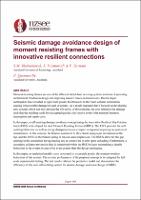Seismic damage avoidance design of moment resisting frames with innovative resilient connection

Download
Date
2020-04-22Authors
Shabankareh, Mohsen
Veismoradi, Sajad
Zarnani, Pouyan
Quenneville, Pierre
Metadata
Show full item recordAbstract
Moment-resisting frames are one of the efficient lateral-load resisting systems in terms of providing architectural freedom in design and imposing smaller forces on foundations. Recent major earthquakes have resulted in significant plastic deformations in the beam-column connections causing irrecoverable damage in such structures. As a result, engineers have focused on developing new systems which not only provide the life-safety of the residents, but also minimise the damage such that the building could be reoccupied quickly after severe events with minimal business interruption and repair costs.
In this paper, a self-centring damage avoidance concept using the innovative Resilient Slip Friction Joint (RSFJ) is developed for steel Moment Resisting Frames (MRFs). The RSFJ provides the self-centring behaviour as well as energy dissipation in one compact component requiring no post-event maintenance. In this concept, the beam is connected to the column using a pin mechanism at the top, and the RSFJs at the bottom acting in tension and compression. The RSFJs allow for the gap opening in the connection during loading and re-centres the system upon unloading. Furthermore, a secondary collapse-prevention fuse is considered within the RSFJ to keep maintaining a ductile behaviour in the system in case of an event greater than the design earthquake.
In this paper, an analytical model is also developed to accurately predict the moment-rotation behaviour of this system. The seismic performance of the proposed concept is investigated by full-scale experimental testing. The test results validate the predictive model and demonstrate the efficiency of this new self-centring system for seismic damage avoidance design of MRFs.
